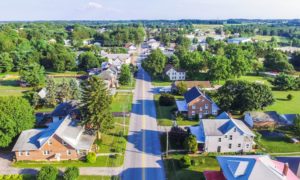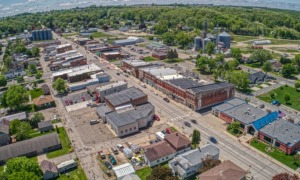
Provided by The Bridgespan Group
.
Six common factors support upward mobility for youth in rural America, a report released today said.
Setting high expectations, focusing early on career pathways and having informal support systems all correlate with young people climbing the income ladder and achieving a higher standard of living, according to data gathered from more than 200 interviews with community leaders and students in 19 U.S. towns.
“What we found were these six factors … that were not just present in all 19 of these towns, but pervasive throughout these towns,” said Mark McKeag, a partner at The Bridgespan Group and one of the authors of the report. “And it just was amazing how common” these themes were.
The Bridgespan Group, a philanthropy and nonprofit consulting firm, produced the report in collaboration with the National 4-H Council and the Cooperative Extension System.
Challenges faced by rural communities, such as high rates of poverty and low rates of college completion, have been well documented. As of 2016, more than 19 percent of young people living in rural areas were neither employed nor attending school, compared to about 12 percent nationwide, according to a report released this year by the Social Science Research Council.
For the Bridgespan study, researchers wanted to switch gears by focusing on rural communities where young people were thriving. They visited 19 towns in rural counties that rank in the top 10 percent for youth economic advancement, all with populations between 600 and 20,000. Interviewers gathered data from the Texas Panhandle, Minnesota, North Dakota and Nebraska.
The factors
The report’s six factors for upward economic mobility include:
- A high expectation that youth will “opt in” and work hard to acquire the skills to build a better future
- Strong informal support systems, with neighbors helping neighbors
- An early focus on career pathways
- A wealth of opportunities for young people to build life skills, regardless of the community’s size
- Creative solutions for accessing opportunities in spite of potential barriers, which could be financial, cultural, logistical or other
- A sense of shared fate and a deep commitment to sustaining the community.
To gain a broader perspective, researchers ran their findings by community leaders in six additional counties with household incomes below the rural median. They found many of the six factors were often present, but not as pervasive as in the high-opportunity counties.
“In many ways, the factors that we identified were aspects of social capital … the links between people and the shared values that help groups work together for their mutual benefit,” said Bridgespan manager Mike Soskis, who co-authored the report.
“Much of what we saw was not as much policy-driven, but more about how some of these communities can take stock of their assets and think about how to work together as effectively as possible,” he added.
Lack of other partners
Researchers found a prime example of this in the town of Gruver, Texas, which has a population of about 1,200. Starting in 2012, volunteers began planting corn on more than 400 acres of farmland that was gifted to the local school district. Today the land generates about $500,000 of crops per year, which is used to fund college scholarships for the town’s graduating seniors.
The report’s findings aren’t surprising, said Jen Rinehart, vice president of policy and research for the Afterschool Alliance.
“What I saw in the executive summary is consistent with some of the work that we’ve done with rural communities and what we’ve heard from parents of children living in rural communities, in terms of the desire for support systems for youth and the importance of community, because there is a lack of other partners in many instances,” she said.
A limited pool of resources, such as businesses and organizations available for partnerships, was a common challenge reported by rural after-school programs in a 2015 Afterschool Alliance survey.
Rinehart says the report presents an opportunity to talk about the resources that are needed to help rural communities do a better job of supporting youth.
“The opportunity to really see social capital at work in these communities was amazing,” McKeag said. “We’re really hopeful that this work does have impact and that it leads to other communities taking a look and taking stock of this.”































